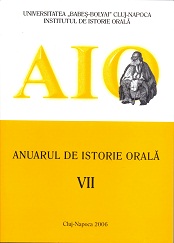MĂRTURII DESPRE O ISTORIE EROICĂ - ISTORIE TRAGICĂ. REZISTENŢA ANTICOMUNISTĂ DIN MUNŢII APUSENI (MUNTELE BĂIŞORII). GRUPUL „DIAMANDI IONESCU”
TESTIMONIES OF A HEROIC HISTORY- TRAGIC HISTORY THE ANTI-COMMUNIST RESISTANCE FROM THE APUSENI MOUNTAINS (BAISORII MOUNTAIN) THE „DIAMANDI IONESCU”
Author(s): Florin StanSubject(s): History
Published by: Argonaut
Summary/Abstract: Between 1948-1949 a group of partisans led by aviation captain Ionescu Diamandi operated in the region of the Lower Ariesului Valley and Ierii Valley (the villages Cheia, Moldoveneşti, Ocoliş, Lungeşti, Lunca Largă, Cheile Runcului, Agriş, Maşca, Iare, Băişoara, Muntele Băişorii). According to the written as well as oral sources, the main operations were conducted around the settlement of Mount Băişorii. They ranged from attacking a store and the tourist lodge to capturing the authorities, locking them in a cellar and declaring the township of Mount Băişorii as one that is „liberated from communism and submitted only to the will of the people”. Following the armed confrontations with the repression armies (summer of 1949), the group scattered and, soon after, the adherents together with their followers were arrested and sentenced to hard years of prison. From those that were captured by the State Police, 12 men were executed: 8 were executed in public, in order to set an example, at Mount Baisorii, Cheile Runcului and Maşca, and other 4 men were executed in prison. Following these events, a myth emerged in the region of Mount Baisorii (probably fabricated by the State Police), according to which the leaders of the group of partisans were in fact members of the State Police sent in the area to investigate the peasants’ position towards the communist regime and to determine those hostile to it to act openly so that they could be identified and arrested or eliminated. The idea lacks obviously consistency, taking into account that these leaders were shot and there are no proofs in this respect. That is why we have attempted to uncover the birth mechanism of such a myth, its diffusion and endurance throughout time. Another significant matter that we addressed was that of the adhesiveness of the formula of anti communist resistance to the population of the investigated villages. It seems that, in the context of the soviet reality that had reached the Transylvanian villages in the form of accounts of the formers combatants on the eastern front, townsmen supported in great numbers the anti communist activities.
Journal: Anuarul Institutului de Istorie Orală
- Issue Year: 2006
- Issue No: VII
- Page Range: 183-196
- Page Count: 14
- Language: Romanian

